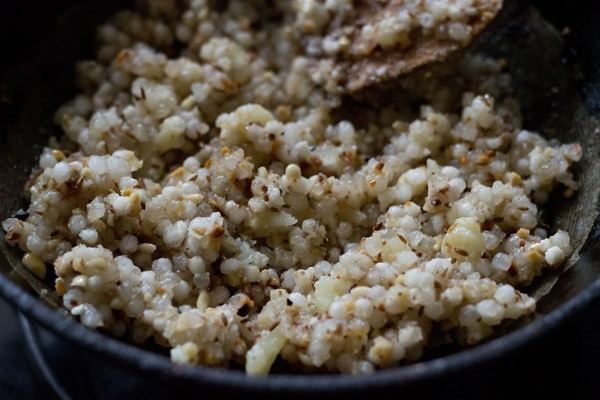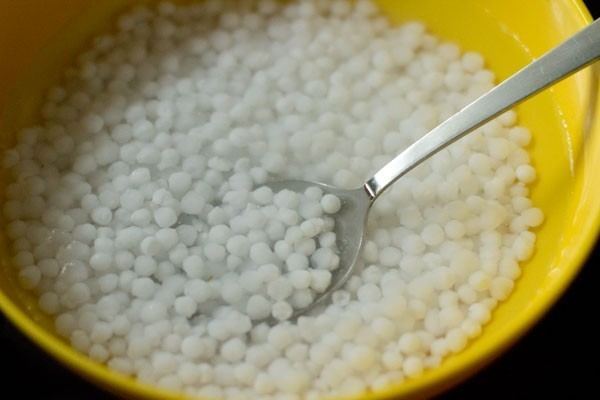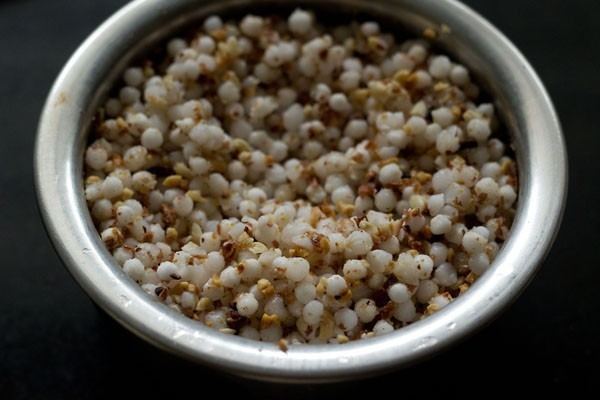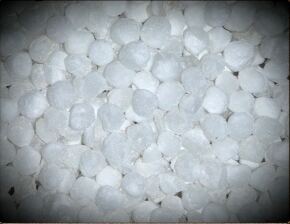 | ||
Similar Sabudana vada, Thalipeeth, Khichdi, Kheer, Vada | ||
Sabudana khichdi spiced tapioca sago indian recipe
Tapioca Sago (Sabudana) is a processed, ready to cook agricultural food product. The only raw material for manufacturing Sabudana is “tapioca root” internationally known as “cassava”. For infants and sick persons or during fasts (vrata-upawas), Sabudana is considered an acceptable form of nutrition . It is used in a variety of dishes such as desserts like “kheer” (boiled with sweetened milk) or Khichadi, vada, bonda etc. (mixed with Potatoes, Ground nuts, rock-salt, black-pepper or green chillies). Tapioca Sago is commonly Known as "SABUDANA साबुदाना" in Hindi, "Sabakki" in Kannada or Javvarisi in Tamil, "Saggubiyyam" in Telugu in India. Sabudana (Sago) is a produce, prepared purely from Tapioca Root ("cassava") Botanical name is “Manihot Esculenta Crantz Syn. Utilissima”.
Contents
- Sabudana khichdi spiced tapioca sago indian recipe
- Sabudana kheer recipe tapioca pudding sago payasam
- About
- History of Sabudana industry in India
- Consumption and uses
- Varieties size colour of Tapioca Sago
- Commercial taxation in different states
- States where Sabudana is Exempted from VAT
- States where Sabudana is not notified under VAT
- States where Sabudana is Taxable 1 under VAT
- States where Sabudana is Taxable 5 under VAT
- Salem Tamil Nadu
- Samarlakota Andhra Pradesh
- References

It closely resembles Sago Palm, as both are typically small (about 2 mm diameter) dry, opaque balls. Both are white in colour (if very pure). When soaked and cooked, both become much larger, translucent, soft and spongy. Both are widely used in and around the world, usually in puddings. Sabudana is made as vadiyalu in Andhra Pradesh and Telangana states. It's boiled with a lot of water and salt, chilli powder are mixed and then dried on a plastic sheet as small papad shaped and dried in sun for two three days and deep fried and eaten as vadiyaalu.

Sabudana kheer recipe tapioca pudding sago payasam
About
In India, the names ‘Sago‘, ‘Tapioca Sago‘, ‘Tapioca Globules‘, ‘Sabudana‘, ‘Javvarisi‘, ‘Sabbakki’, ‘Saggubeeyam‘ are all used for the same commodity ‘Sabudana’. It is called ‘Javvarisi‘ in Tamil, ‘Sabudana‘ in Hindi, Bengali, Gujarati, Punjabi & Marathi, ‘Sabbakki’ (in Kannada), ‘Chavvari’ (in Malayalam) and ‘Saggubeeyam’ (in Telugu) among other regional and local names. The word Tapioca and ‘Tapioca Root (Cassava)’has different meanings. “Tapioca” is a product being extracted from cassava root (Manihot esculenta), shaped in lump forms,roasted and dried. In Brazil, cassava is called mandioca while its starch is called tapioca, a word derived from the word tipi’óka, its name in the Tupí language spoken by natives when the Portuguese first arrived in the North-east Region of Brazil. This Tupí word refers to the process by which the cassava starch made edible. As the food and word taken to other world regions, “tapioca” was applied to similar food preparations. In India, the term “Tapioca-Root” is used to represent the tuber of cassava and word ‘Tapioca’ represents for derived starch from cassava roasted in a particular shape.

This is a well known crop that is recognized by several names in the various regions where it is consumed. It is known as yuca, rumu or manioca in Latin America, manioc in French-speaking Africa and Madagascar, cassava in English-speaking Africa, Ceylon and Thailand, mandioca or aipim in Brazil, tapioca in India and Malaysia, and bi ketella or kaspe in Indonesia (FAO, 1998). Sweet varieties of the crop such as Manihot utilissima Pohl are reported to have lower levels of cyanogenic glycosides, while bitter-tasting varieties exemplified by cultivars such as Manihot palmata Muell and Manihot aipr Pohl are thought to have higher levels of cyanogenic glycosides. These cultivars fall within the species Manihot esculenta Crantz which belongs to the family Euphorblaceae (Dixon, 1979; Lancaster et al., 1982; FAO 1998).

Tapioca root has a high resistance to plant disease and high tolerance to extreme stress conditions such as periods of drought and poor soils. Fresh roots contain about 60 – 70% moisture, 7 – 12% protein, 5 – 13% starch (32 – 35% total carbohydrate) and trace amounts of fat (Lancaster et al., 1982; Jackson, 1990; FAO, 1998). The high starch and moisture content render it extremely perishable. (Hahn 1989; Mlingi et al., 1996). Processing is therefore indispensable to facilitate preservation, improve palatability and product quality as well as reduce cyanogenic glycoside toxicity (Jones, 1998).

The cassava or manioc plant has its origin in South America. Amazonian Indians used cassava instead of or in addition to rice/potato/maize. Portuguese explorers introduced cassava to Africa through their trade with the African coasts and nearby islands.
Tapioca was introduced in India during the later part of the 19th Century, Now, mainly grown in the States of Kerala, Andhra Pradesh, & Tamil Nadu. Products from Tapioca like Starch & Sago introduced in India only in the 1940s upwards. First by hand manually & later developed indigenous production methods.
Currently, The Tamil Nadu State stands first in respect of processing of tapioca into starch & sago, in India. In India, Sago was produced first in Salem (Tamil Nadu)in 1943-44, about some 50 years ago. Sago production started on a cottage scale basis in India by pulping the tapioca roots, filtering the milk-extract and after settling the milk, forming globules and roasting these globules.
Tapioca Root is the basic raw material for Sago and starch. There is about 30% to 35% starch contents generally in Indian tapioca root. India is one of the leading countries in tapioca production. About 650 to 700 units is engaged in tapioca processing in Salem district (Tamil Nadu State). It is a very nutritious product as it contains Carbohydrates and appreciable amount of Calcium and Vitamin-C.
The Root, received from the farms are hygienically cleaned in water. After peeling the skin, it is crushed, allowed to pass the milk after retaining all fiber & impurities. The milk is settled in a tank for nearly 3 to 8 hours. Thus, all residual impurities float to the top of the tank and are drained out of the settled milk. From this settled Milk Cake, Globules are made by a unique type of system, on a very simple indigenous machine. After sizing the globules by filtering through sieve, it is roasted on hot plates or heated in steam, depending upon the desired final product and then dried under direct sunlight on large platforms.
Roasted Sago is known as Tapioca Sago Common and Boiled Sago as Nylon Tapioca Sago.
History of Sabudana industry in India
The Tapioca Sago and Tapioca starch industry of Tamil Nadu is the result of scarcity created by the impossibility of imports of foreign sago and starch from Singapore, Malaysia, the Netherlands, Japan and the U.S., during the Second World War. In the year 1943, Mr. Manickam Chettiar, a dry fish merchant of Salem had the occasions to go to Kerala very often in connection with the trade. He found Tapioca flour to be a good substitute for the American Corn flour. Shri Popatlal G. Shah, an evacuee from Penang (Malaysia) came in touch with Shri Manickam and taught him the technical know-how to manufacture sago out of tapioca root. Thus, tapioca was used in 1943 to manufacture both starch and sago. But the methods adopted were crude and primitive.
In order to meet the daily increasing demand for sago and starch, Mr. Manickam with the help of a genius mechanic Shri M. Venkatachalam Gounder improved the methods and machinery of production. The productive capacity of the industry increased from 2 bags of 100 kilos to 25 bags per day. In 1944 there was a severe famine in the country as a whole, and tapioca being edible, the collector of Salem prohibited the export of tapioca from Salem District.
The Salem sago and starch manufactures though very few formed an association and represented their case before the Civil Supply Commissioner and got the prohibitory order of the District Collector and also that of Madras Government for the export of sago and starch to other states cancelled. In 1945 production of sago and tapioca starch increased appreciably.
The sago and tapioca starch industry was born during the Second World War. But the aftermath of the war posed a severe threat to its existence. The Second World War was over and imports of starch and sago began to increase from foreign countries under general license No. XI.
Sago and starch manufacturers made the successful representation to Sri. C. Rajagopalachari, the civil Supplies and Industries Minister in the Interim Government and it resulted in the banning of imports of sago, which was extended up to 1949.
The Tariff Board also gave protection to sago industry from time to time up to 1957 in one way or other.
In 1957, misguided by some government officers and jealous persons, the Calcutta Corporation with the help of the Enforcement Branch seized about 8000 bags of sago from the traders in Calcutta under the bogey that Salem sago was not fit for human consumption. The action of Calcutta Corporation was terrific on the sago industry, and its price came down to Rs.20 per bag from Rs.65 within one month. Many manufacturers ceased the production and the agriculturists decided to switch over to the cultivation of other crops. This was the worst crisis faced by the industry since 1943.
The Sago manufacturers association faced the crisis boldly. They filed a case before the Supreme Court of India, against Calcutta Corporation. The sago manufacturer successfully established, by the analytical report that there was practically no difference between the good imported sago and the Indian product. They won the case. From that time Salem sago was also brought under Processed Food Act. Sago industry was thus saved.(Case Law Citation needed)
In 1949, there were 45 units with about 7000 tonnes production of sago and starch. In 1957, there were 125 units producing about 23000 tonnes of sago and starch.
In 1993, there were about 852 units in India out of which 725 units are located in Tamil Nadu. In Salem District alone there are 649 units constituting 89.5 percent. In 2008-09 there were about 359 sago industries located in Tamil Nadu. In Salem District alone 120 units are located in Attur and Gangavalli area.
Tapioca waste like Thippi (remaining after starch and sago) is extensively used as cattle feed and the powder extracted from this residue known as Thippi flour or paste flour is used for various pasting purposes.
Sago and tapioca starch industry in Salem District and Tamil Nadu has had a phenomenal growth in the last 47 years. Though it is a recent industry of Tamil Nadu, its role particularly in Salem economy is very great indeed. It has already affected and has vastly increased the trade potential in addition to giving scope for employment opportunities for labour.
According to FAO classification, Root and tuber crops form staple diet for three percent of the global population. Cassava is mostly used for human consumption in the African continent and South America. Industrial utilization of cassava is prominent in Thailand, Indonesia, Vietnam and India in the form of Cassava-Starch i.e. Tapioca Starch, Sabudana (Sago), Dried chips, Flour and the like. However today, sabudana is artificially made in factories most of the times.
Consumption and uses
In India, major consuming states of Sabudana (Tapioca Sago) are Maharashtra, West Bengal, Bihar, Uttar Pradesh, Madhya Pradesh, Rajasthan, Jharkhand, Gujarat and Andhra Pradesh. Consumption in other states is low. Even in Tamil Nadu (main producing state), the consumption is only about 2 to 3% of total Sabudana production. Uses of Sabudana in the country is completely as a food, especially on days of fasting (vrat-upawas), i.e., Navratri, Shraavana, Ekadashi, Purnima period. Sabudana is rich in complex carbohydrates, digests slowly, and thus, does not give any feelings of empty stomach. Sabudana is used in many dishes, some of the more popular being Khichadi, Vada, Bonda, Kheer, Halwa etc. Some people make specific items like Khichia, Papad, Chakali etc. by boiling Sabudana. Sabudana can also be used in homemade facial masks and hair masks, the pearls can be mashed and mixed with Honey & Lemon or Avocados or Chamomile Tea to make a thick paste. This paste helps to smoothen the skin and eradicate acne and scars from the face.
Varieties, size & colour of Tapioca Sago
Currently, in 2014, There are two varieties popular in India. First, Common Sabudana, which is Roasted and dried and Second, Nylon Sabudana, which is steam boiled and dried.(1) between 1mm to 1.5 mm dia (locally known as Motidana and popularly used in Eastern part of India),
(2) between 2 mm to 2.5 mm dia (it is international standard size and locally known as ‘Khirdana’), and
(3) between 3 mm to 4 mm dia (the common popular size all over India, locally called ‘Badadana’).
(1) of 2 mm dia (locally known as ‘Chinidana’ or ‘Smaller Ceylon nylon’),
(2) of 3 mm dia (popularly called as ‘Ceylon Nylon'), and
(3) between 5 to 7 mm dia (which is called locally as ‘Glass Nylon’ or 'Phooldana')
The roasted variety absorbs more water than the boiled variety, whereas, if fried, the boiled variety expands more than roasted sabudana. Similarly, Boiled Sabudana variety has more transparency in appearance, whereas Roasted Variety has no transparency.Colour of the two varieties are also different, as Boiled variety becomes glowing transparent creamer-yellow colour, whereas Roasted variety retains the original natural white colour of cassava extract like Milk colour.
Commercial taxation in different states
As on 30 August 2015, the rates of Local Taxes on Sabudana ( Sago, Tapioca Globules, Tapioca Sago)are as follows:
States where Sabudana is Exempted from VAT
1. Assam ( Sago and Tapioca Globules, First Schedule) ,
2. Bihar ( Sago and Tapioca Globules, Schedule- I ),
3. Chattishgarh ( Sabudana, under Kirana goods),
4. Gujarat ( Sabudana, Schedule- I ),
5. Himachal Pradesh ( Tapioca and their seeds, Schedule - B ),
6. Jharkhand ( Sabudana, Schedule - I ),
7. Madhya Pradesh ( Sabudana, Schedule - I ),
8. Nagaland ( Sago, Schedule - I ),
9. Rajasthan ( Sabudana, Schedule - I ),
10.West Bengal ( Sago and Tapioca Globules, Schedule – A )
States where Sabudana is not notified under VAT
1. Arunachal Pradesh,
2. Goa,
3. Jammu & Kashmir
4. Sikkim,
5. Tripura,
6. Uttarakhand
7. Andaman and Nicobar Island (UT),
8. Daman and Diu (UT),
9. Lakshadweep (UT),
10.Puducherry (UT)
States where Sabudana is Taxable @1% under VAT
1. Manipur ( Starch and Sago, Schedule – I )
2. Odisha (Starch and Sago, Schedule – B )
States where Sabudana is Taxable @5% under VAT
1. Andhra Pradesh ( Starch and Sago, Schedule – IV )
2. Haryana ( Sago(Sabudana), Schedule – C )
3. Karnataka ( Starch including Sago, Third Schedule )
4. Kerala ( Sago, Schedule – III )
5. Maharashtra ( Starch, Sago and Tapioca, Schedule – C )
6. Meghalaya ( All Processed Fruits-Vegetables etc.., Schedule – II )
7. Mizoram ( Processed or preserved vegetables.., Schedule – II )
8. Punjab ( Sabudana, Schedule – B )
9. Tamilnadu ( 2120- Sago of all kinds, Schedule – I, Part – B )
10.Telangana ( Starch and Sago, Schedule – IV )
11.Uttar Pradesh ( 2A118002 – Starch, Sago and Sabudana, Schedule – II )4%
12.Chandigarh(UT) ( Processed fruits, vegetables, Schedule – B )4%
13.Delhi(UT) (Sabudana, Schedule – III )
Salem (Tamil Nadu)
In India, in around 1943-44, Sago production was started first in Salem (Tamil Nadu) on a cottage scale basis by crushing & pulping the tapioca roots, filtering the milk-extract and after settling the milk, forming globules and roasting these globules. Till that time, cassava was used for direct food as cooked tubers. After 1945 only industry developed its indigenous machineries locally and start marketing its products all over India. Before that period, Sago was an imported item in India and consumption was in very limited quantity (only for sick persons or for infants as were prescribed by Doctors).
Currently, in Tamil Nadu alone, cassava is being cultivated over an area of about 82000 hectares providing employment for thousands of workers over fields and in 800 processing units. In Salem District alone, 34000 hectares of land is under cassava cultivation and there are 650 units engaged in tapioca processing.
There is volatility in yearly production of Tapioca Sago-Starch in the region. In 2001-02 At The Sagoserve, there was Total Turnover of Sago-Starch of 24.41 lakh bags valued Rs. 20470.37 lakh, whereas in 2012-13 the total Turnover of Sago-Starch was of only 12.92 lakh bags for total value of Rs. 35448.04. (source: http://www.sagoserve.com/Growth.htm )
Samarlakota (Andhra Pradesh)
In Andhra Pradesh, Sago manufacturing was started first in Samarlakot, East Godavari region in 1966. Up to, 1980 sago manufacturers were completely dependent on Calcutta market, as till that time they brought their product for sale on commission basis through Calcutta Agents only. First Sago factory was started in 1949-50 and number of sago factories in the area went up to 53 in 80s. Gradually it has come down and currently in the year 2014, there are only 20 factories are running. After 1980, they started to follow Salem industry and started to sell their products in other states through agents.
Total Area (in Hectares) of Land under Cassava Cultivation was about 60000 acres in 2013-14 and about 70000 acres in current year i.e. 2014-15.
There is no any authentic data available for sago-starch manufactured in and marketed from Andhra Pradesh. Currently, in 2014, there are only 20 mills are running. (source: venkatrao-at-gopalstarch.com)
